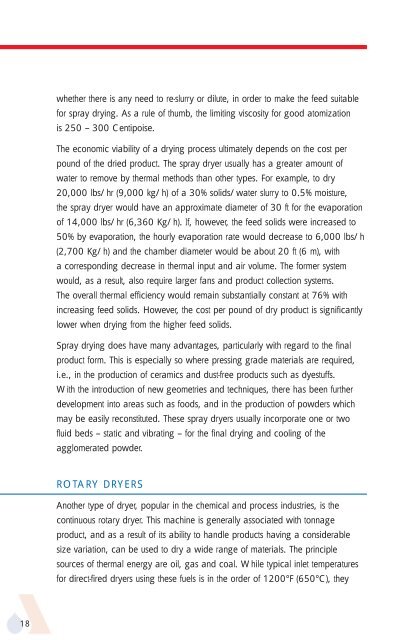APV Dryer Handbook - Umbc
APV Dryer Handbook - Umbc
APV Dryer Handbook - Umbc
Create successful ePaper yourself
Turn your PDF publications into a flip-book with our unique Google optimized e-Paper software.
18<br />
whether there is any need to re-slurry or dilute, in order to make the feed suitable<br />
for spray drying. As a rule of thumb, the limiting viscosity for good atomization<br />
is 250 – 300 Centipoise.<br />
The economic viability of a drying process ultimately depends on the cost per<br />
pound of the dried product. The spray dryer usually has a greater amount of<br />
water to remove by thermal methods than other types. For example, to dry<br />
20,000 lbs/hr (9,000 kg/h) of a 30% solids/water slurry to 0.5% moisture,<br />
the spray dryer would have an approximate diameter of 30 ft for the evaporation<br />
of 14,000 lbs/hr (6,360 Kg/h). If, however, the feed solids were increased to<br />
50% by evaporation, the hourly evaporation rate would decrease to 6,000 lbs/h<br />
(2,700 Kg/h) and the chamber diameter would be about 20 ft (6 m), with<br />
a corresponding decrease in thermal input and air volume. The former system<br />
would, as a result, also require larger fans and product collection systems.<br />
The overall thermal efficiency would remain substantially constant at 76% with<br />
increasing feed solids. However, the cost per pound of dry product is significantly<br />
lower when drying from the higher feed solids.<br />
Spray drying does have many advantages, particularly with regard to the final<br />
product form. This is especially so where pressing grade materials are required,<br />
i.e., in the production of ceramics and dust-free products such as dyestuffs.<br />
With the introduction of new geometries and techniques, there has been further<br />
development into areas such as foods, and in the production of powders which<br />
may be easily reconstituted. These spray dryers usually incorporate one or two<br />
fluid beds – static and vibrating – for the final drying and cooling of the<br />
agglomerated powder.<br />
ROTARY DRYERS<br />
Another type of dryer, popular in the chemical and process industries, is the<br />
continuous rotary dryer. This machine is generally associated with tonnage<br />
product, and as a result of its ability to handle products having a considerable<br />
size variation, can be used to dry a wide range of materials. The principle<br />
sources of thermal energy are oil, gas and coal. While typical inlet temperatures<br />
for direct-fired dryers using these fuels is in the order of 1200°F (650°C), they











